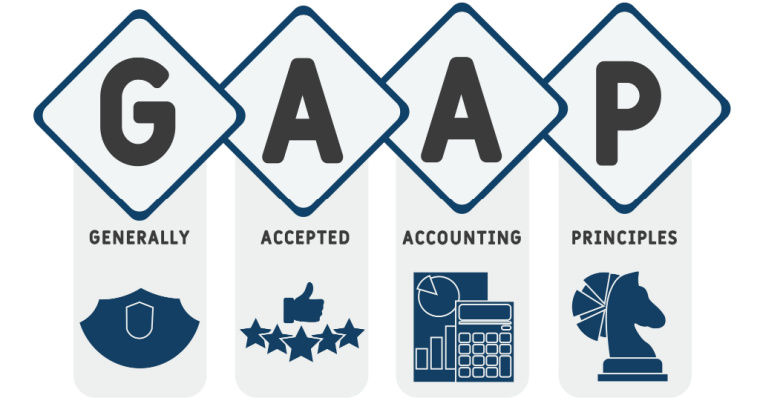What is GAAP in Financial Reporting and How is it Different from IFRS?

Businesses need financial reporting at every stage. It makes the business owners and other stakeholders aware about its financial performance. Financial reporting makes a record of relevant information about a company, including its expenses, revenues, current financial position, and related disclosures.
A business’s financial reports could help raise capital, initial public offerings (IPO), mergers & acquisitions, business loans, grants, and loan forgiveness. For these internal and external purposes, a standardized accounting system helps maintain consistency. It also allows the comparison of the company’s performance with other companies. This is where the use of Generally Accepted Accounting Principles or GAAP comes to the forefront.
Read on as we discuss what GAAP is, how does it work, why it is important, its benefits and drawbacks among other key pointers.
What is GAAP?
The full form of GAAP is Generally Accepted Accounting Principles – meaning the guidelines by which the majority of financial professionals in the U.S. conduct the financial reporting for a business. The Financial Accounting Standards Board (FASB) and the Governmental Accounting Standards Board (GASB) jointly created GAAP principles in the U.S. in the 1970s.
The US GAAP ensures consistency and standardization in financial reporting. It makes comparison across multiple companies possible. Only the publicly traded companies and the companies that need to publicly release their financial statements need to necessarily adhere to GAAP accounting as per the U.S. Securities and Exchange Commission (SEC). However, several financial professionals like bookkeepers, controllers, and accountants also follow the GAAP guidelines, especially for companies that are looking to go public, or carry out mergers and acquisitions, raising capital, etc., in the future.
The Stock Market Crash of 1929 followed by the Great Depression became the reason behind the establishment of GAAP accounting principles. One of the many reasons behind the two events was the faulty financial reporting practices followed by many publicly-traded companies. Thus, the need for professional accounting was felt, and GAAP was eventually brought into existence.
How Does GAAP Work?
The publicly-traded companies have to issue reports about their finances from time to time. These reports include the taxes, revenues, profits, routine and one-time expenses, etc. The companies issue these reports to their lenders, donors, taxpayers, and investors.
An investor needs to have a clear understanding of the finances of the company he invests in. He should also trust that the information he gets about the company’s revenues, expenses, and operations are correct. If the companies start using different account methods to report their financials, there would be no uniformity in the financial reports of companies. Additionally, the investors would not have a uniform convention by which they can compare the financial reports of different companies.
Investors and stakeholders can be rest assured of the accuracy of a company’s financial reports if they use GAAP accounting. GAAP is based on the following guidelines:
- Recognition: Financial experts can get an understanding of what should be included in a financial report from GAAP.
- Measurements: GAAP also outlines the amount of all the components included in a financial report.
- Presentation: The GAAP accounting standards define the presentation of the line items and subtotals that should appear and be aggregated in the financial reports.
- Disclosure: GAAP identifies and discloses the information that is crucial for the investors. It gives context for this information in the reports.
The U.S. FASB provides multiple templates to the companies to help them follow the correct reporting guidelines. It grants reasonable leeway to companies on how they detail the expenses and revenues in the financial reports.
Also Read
Importance of GAAP
- GAAP helps foster trust in the financial markets for different stakeholders and investors.
- GAAP gives a boost to market investments.
- GAAP facilitates apple-to-apple comparisons between companies for investors.
- GAAP brings about standardisation and transparency in financial reporting.
- GAAP requires nonprofit and government entities to honestly lay down their finances. They become more accountable due to GAAP.
- GAAP makes it easier for people to read and understand a company’s financial report.
- GAAP throws light on the financial health of a business.
- Business owners can compare the performance of their business over the months using financial statements made using GAAP.
- GAAP is crucial for external business activities like mergers and acquisitions, loans, public trading, etc.
Principles of GAAP
The 10 core GAAP principles lay out the principles of this accounting methodology.
1. Principle of consistency
GAAP ensures that financial professionals make use of the same accounting standards from period to period. It ensures compatibility between one period and the next. A company has the freedom to use the accounting procedure of its preference while recording its transactions, but the accounting procedure should be the same over different periods.
2. Principle of permanent methods
Similar to the principle of consistency, the principle of permanent methods states that there should be uniformity in the practices of financial reporting for easier comparisons.
3. Principle of non-compensation
The principle of non-compensation states that all the positive and negative aspects of a company’s performance should be reported in its financial statements, and the financial professionals should not compensate any of the company’s liability with its assets.
4. Principle of prudence
The principle of prudence lays emphasis on factual financial data representation that is reasonable and prudent and not based on any kind of speculation.
5. Principle of regularity
According to this principle, all the accounts must adhere to the GAAP principles and standards.
6. Principle of sincerity
The principle of sincerity states that financial professionals should function with utmost sincerity and honesty, and try their best to give accurate financial reports of a company without any partiality.
7. Principle of good faith
Similar to the previous principle, the principle of good faith states that the financial professionals and the companies should do honest and complete reporting of the company’s financials.
8. Principle of materiality
The principle of materiality states that financial professionals must try to disclose the complete financial data and accounting information of the company in the financial reports they present.
9. Principle of continuity
This principle of GAAP states that all the asset valuations in the financial statement of a company are based on the assumption that the business would remain in existence and would keep operating in the future.
10. Principle of periodicity
This GAAP principle refers to the standardisation in financial reporting periods, like quarterly, monthly, annually, etc.
How are Generally Accepted Accounting Principles Used?
The U.S. SEC makes it mandatory for all publicly-traded companies to file their GAAP-compliant financial statements. It enables them to continue to be listed on the U.S. stock exchanges. An external audit conducted by a certified public accounting firm audits a company’s financial statements to ensure they are GAAP-compliant.
GAAP accounting is not compulsory for non-publicly traded companies, but lenders and creditors usually ask for GAAP-compliant financial reports of a company before giving it a business loan. In the absence of GAAP-compliant accounting, it could become very difficult for creditors, investors, and other stakeholders to compare the financial statements of different companies. Therefore, most companies, even if they are not publicly listed, follow GAAP.
Benefits of GAAP
- GAAP helps offer an accurate picture of a company’s finances. It aids the business owners to create and follow realistic future plans. The detailed records given in the GAAP-compliant financial reports save the company from skipping essential things and determine cash flow trends for the company.
- GAAP helps make financial statements usable and consistent. It eliminates confusion from financial statements and brings a sense of trust among the stakeholders.
- GAAP helps significantly reduce instances of a company’s data misrepresentation and fraud.
- A company can compare its financial statements with other similar companies in the industry and identify the scope for improvement through this competitive analysis.
- GAAP gives a detailed study of the costs a company has incurred, leading to wiser spending decisions.
Limitations of GAAP
- GAAP is not a global financial reporting standard. It makes it hard to use GAAP accounting for businesses that have overseas operations.
- GAAP does not account for the diversity among companies and uses the same principles for all kinds of businesses in an industry. This could make using GAAP difficult for small companies and other diverse businesses.
- Policymakers revise and make new GAAP standards. The policy boards go through extensive and time-consuming processes to create and implement the new standards. GAAP-compliant companies have to wait for a long time until these new standards are implemented.
GAAP vs. IFRS
Just like GAAP, the International Financial Reporting Standards (IFRS) also aims at standardising accounting principles for companies in different countries.
The basic difference between GAAP and IFRS is that GAAP is more rule-based and gives detailed and specific instructions for financial professionals under different scenarios. IFRS is more principle-based and flexible than GAAP.
GAAP is predominantly used in the U.S. and a few other countries. On the other hand, IFRS is used in over 120 countries across the globe and is more universally accepted.
Also Read
Final Word
GAAP was created through a collaboration between the government and the businesses but is not regulated or controlled by the government. Although it is not mandatory for all kinds of businesses, it is beneficial in multiple ways for a company. GAAP has brought significant improvement in comparability, verifiability, relevance, and transparency of financial reports.
FAQs
Ans. The GAAP full form in accounting is Generally Accepted Accounting Principles.
Ans. GAAP is a set of rules and principles that should be used to prepare the financial reports of all publicly traded companies in the U.S.
Ans. The Financial Accounting Standards Board (FASB) and the Governmental Accounting Standards Board (GASB) jointly created GAAP principles in the 1970s.
Ans. GAAP allows investors to compare the financial health and performance of a company to other companies in an industry. It also helps investors compare the financial performance of a company between different periods.
Ans. GAAP allows the company to see the costs incurred in a period and reduce them accordingly. It helps the company see its actual financial position and make the required future financial plans. A company can compare its performance with its competitors and see where it is going wrong to improve its future performance.
Disclaimer
This article is solely for educational purposes. Navi doesn't take any responsibility for the information or claims made in the blog.

Customer’s Feedback
No comments found.What is Primary Deficit? – Example, Formula & Measures
What is a Primary Deficit? Primary Deficit is the difference between the current year’s fiscal... Read More »What is Financial Ratio Analysis? – Objectives, Types and Uses
Ratio analysis is a process that allows people to assess the financial health of a company. Using t... Read More »Treasury Management – Its Functions, Types and Benefits
Even the most well-funded business can run into huge losses if it does not have the resources to fu... Read More »How Anti Money Laundering Combats Financial Crime?
Anti Money Laundering (AML) is a system of rules, laws, regulations, and procedures that financial ... Read More »What is Salvage Value and Why is it Useful?
Salvage value, also called scrap value, is the value of a specific asset after its useful life. In ... Read More »Key Difference Between Factoring and Forfaiting in Trade Finance
Factoring and forfaiting have grown in prominence as major sources of export financing. For the uni... Read More »What is Factoring and its Importance in Financial Management?
Factoring is a practice in which a company buys the accounts receivable of another company at a dis... Read More »What is Budget Surplus: Its Effects, Advantages and Impact with Examples
When the revenue of a government, business, or individual exceeds its expenses in a given period, i... Read More »What is Balanced Budget – Components, Importance and Examples
In financial planning or the budgeting process, a balanced budget is one in which total anticipated... Read More »What Does Inflationary Gap Mean in Macroeconomics?
In macroeconomics, the difference between current and potential GDP is known as a gap. This gap is ... Read More »What is Accounting Conservatism in Finance and How Does it Work?
Accounting conservatism involves a conservative set of accounting guidelines wherein the worst-case... Read More »Multiple Linear Regression (MLP) – Uses, Formula and Examples
Various statistical models help in establishing a relationship between different variables. Multipl... Read More »Top 10 Chit Fund Schemes in India in 2023
Chit funds are one of the most popular return-generating saving schemes in India. It is a financial... Read More »10 Best Gold ETFs in India to Invest in April 2023
Gold ETFs or Gold Exchange Traded Funds are passively managed funds that track the price of physica... Read More »10 Best Demat Accounts in India for Beginners in 2023
Creation of Demat accounts revolutionised the way trades were conducted at the stock exchanges. It... Read More »20 Best Index Funds to Invest in India in April 2023
What is an Index Fund? An index fund is a type of mutual fund or exchange-traded fund (ETF) that... Read More »Best Arbitrage Mutual Funds to Invest in India in April 2023
Arbitrage funds are hybrid mutual fund schemes that aim to make low-risk profits by buying and sell... Read More »10 Best SIP Plans in India to Invest in April 2023
What is SIP? SIP or Systematic Investment Plan is a method of investing a fixed amount in ... Read More »10 Best Corporate Bond Funds in India to Invest in April 2023
Corporate bond funds are debt funds that invest at least 80% of the investment corpus in companies ... Read More »10 Best Bank for Savings Account in India [Highest Interest Rate 2023]
Savings account is a type of financial instrument offered by several banks. It lets you safely depo... Read More »


































